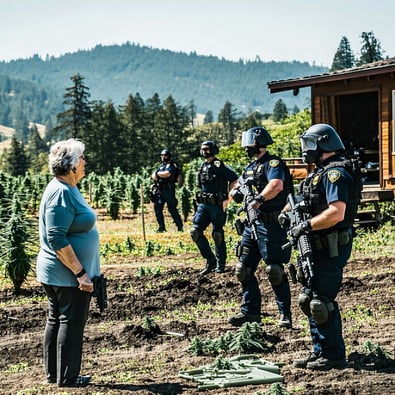Ohio Cannabis Growers Call for Clearer Laws Following Raids During Flyover Operation.
Greene County property owners whose properties were raided during a cannabis flyover operation in August say more needs to be done to clarify home grow law — for law enforcement and citizens alike.
Chris Thompson’s Fairborn-area home was one of the properties visited by area law enforcement agencies during the Agencies for Combined Enforcement (ACE) Task Force and Ohio Bureau of Criminal Investigation (BCI) flyovers on Aug. 13.
“(Officers) showed up and told me they were here to educate. I asked, you need 30 people to educate us?” said Thompson in an interview with the Dayton Daily News.
The Fairborn man said he was home alone when he noticed a helicopter floating around his property, and he initially thought police were searching for a runaway suspect or a missing person.
“Ten or 20 minutes pass with them circling around, and I’m like, ‘Wait a minute. I think they’re coming to talk to me,’” Thomspon said.
Thompson then said he was visited by dozens of armed officers asking about his patch of cannabis plants. His eight plants — under the legal limit for his household — looked like 25 from the helicopter, officers told him.
ACE Task Force records obtained by the Dayton Daily News say the team was conducting “an annual marijuana eradication” effort, possibly the first such effort since home-growing marijuana became legal in Ohio last year.
The records indicate some of the actions resulted in marijuana being seized. But in at least two cases — Thompson’s and another in Yellow Springs — no plants were seized and the property owners questioned the aggressive tactics.
The Yellow Springs property owners did not respond to a request for comment from the Dayton Daily News. The couple, Mijanou and Kyle Lewis, told Yellow Springs News that they had a dozen cannabis plants at their home when a team of officers came onto their property, but officers reportedly told them they counted 40 plants from the sky.
Mijanou Lewis told Yellow Springs News that her husband, a horticulturist, grows dozens of exotic plants in their yard space — not just the legal number of cannabis plants their household can keep.
“They didn’t know the difference between swamp hibiscus and marijuana,” she told Yellow Springs News.
Task force records say officers gave the home growers instructions on how to legally secure their plants.
Sheriff’s office responds
Greene County Sheriff Scott Anger said flyover operations occur annually through the ACE Drug Task Force and Ohio BCI. The taskforce is a regional partnership that includes the sheriff’s office.
“If people are outside the scope of the law, our job is to help them to get back in the right direction,” he said. “And it’s something we do in partnership with the state. A lot of counties do this on a routine basis.”
The team of law enforcement officers previously would hunt for properties with any cannabis during their flyover missions. Often, they respond in larger numbers to properties with cannabis for officer safety, Anger said.
But the citizen-initiated statute approved last year by Ohioans allows residents 21 and over to grow and keep cannabis plants on their property.
Many adults in Ohio who are 21 and older can lawfully grow and keep six to 12 cannabis plants on their property — six for adults living by themselves and 12 for households with more than one adult in the home.
Per Ohio law, these plants must be contained in a “secured closet, room, greenhouse, or other enclosed area in or on the grounds of the residence that prevents access by individuals less than twenty-one years of age, and which is not visible by normal unaided vision from a public space.”
This is what is tricky to members of the public who want to home grow, Thompson said.
He kept his cannabis plants in a tall, outdoor dog enclosure, tucked away on his property and away from view from the street or adjacent properties.
“It’s designed to keep in German Shepherds,” he said. “As far as safe, secured and enclosed… if a German Shepherd can’t get through it, you can only go so far.”
But according to law enforcement agencies that visited him last month, these efforts weren’t quite enough. Anger said enclosures without roofs could still allow a person to access cannabis plants. The major concern of his agency is youth access to cannabis.
Anger said he understands the law is still new to Ohioans. He said he and other law enforcement leaders had hopes Ohio cannabis law would be clarified by state lawmakers after legalization kicked off last year, but that hasn’t happened as of this week.
“With every right you have a responsibility. If you’re going to be growing, it’s important for you to know the law,” he said. “But can ‘enclosed’ be defined much better? Absolutely.”
Anger said officers participating in the task force’s flyover had the law change in mind, not issuing citations to households with plants under the legal limit or to adults who did not have roofs on their greenhouse spaces or other enclosures.
Thompson said he also does not want youth accessing cannabis, but he did not find the flyover operations to be educational. He said he felt afraid when he saw a large group of people coming onto his property and struggled with sleeplessness and other health concerns following the raid.
“There has to be a better way to educate people than this,” he said.
Thompson said he asked for a written warning with clear directions on how he should proceed with enclosing his plants, but he never received one. Since the flyovers, Thompson has added a roof to his cannabis enclosure.





